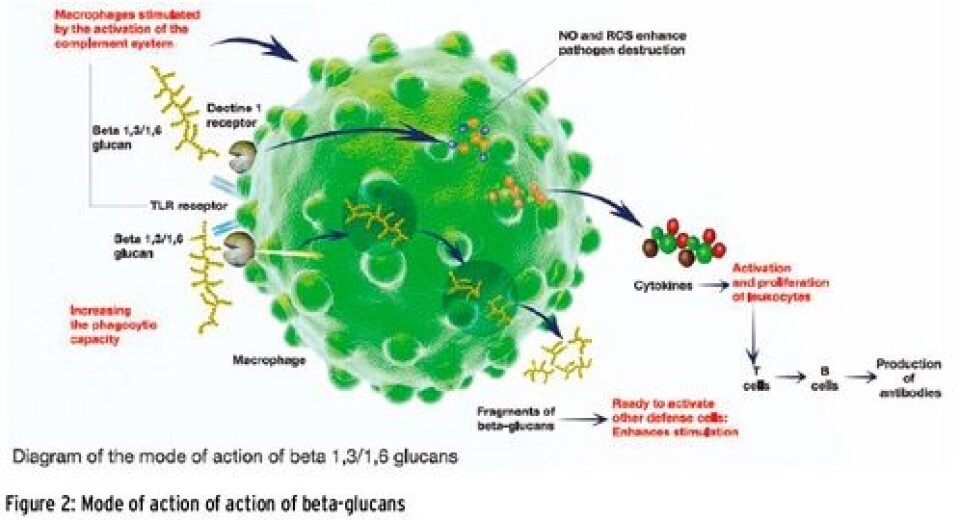Purified beta glucans as a preventative tool in modern aquaculture
By Odd Elvebø, Biorigin Europe

Beta glucan history Even if the history of glucans in feed is short, the story of glucans starts in China 2000 years ago. In ancient China they used an extract of a mushroom that contained beta-1,3/1,6-glucans as a cure for diseases, but it wasn´t until modern times that we realized the active substances in fact were glucans. Despite the history of glucans in feed being relatively short, their use dates back 2000 years ago, in China. The ancient Chinese used extracts from mushrooms for medicinal purposes, but it wasn’t until the 1970’s that the active substance in the mushroom extracts was identified as beta-1,3/1,6-glucans.
More than 50 years ago, scientists in the United States discovered that disrupted, enzyme-digested bakers’ yeast contained a component that had the ability to enhance disease resistance. This crude digest of yeast cells was called zymosan.
In the 1960s and 70s evidence began to accumulate that the active component of zymosan was a beta-1,3/1,6-glucan. In the past 20 to 30 years much work has been devoted to developing methods to extract this beta-1,3/1,6-glucan from bakers’ yeast in a pure and active form, and to reveal its chemical structure and mode of action on the immune system. Today the mode of action of the yeast beta-1,3/1,6-glucan has been extensively researched and its ability to boost defensive responses to infections caused by viruses, bacteria, fungi and parasites has been widely documented in scientific papers, and confirmed by practical experience.
During the last 25 years, much work has been carried out to develop large scale processes and new methods to extract the yeast beta-1,3/1,6-glucan in its pure and active form, and the industrial scale production of MacroGard® (molecular structure shown in Figure 1) is a successful result of this work.

Where to find beta-1,3/1,6-glucan? Bakers’ yeast (Saccharomyces cerevisiae) is a very good source for beta-1,3/1,6-glucan with high bioactivity. The beta-1,3/1,6-glucan MacroGard® is extracted from the cell wall of bakers’ yeast by a unique and patented purification method.
Intact cells of baker’s yeast do not activate the immune system, because the biologically active beta-1,3/1,6-glucan is enclosed within the cell walls and covered by components (mannano-proteins) which are not removed by the normal digestion process in the gut. Therefore, to make a bioactive product, these surface components have to be removed in a technological process, which at the same time releases and exposes the beta-1,3/1,6-glucan in its active form. This is a crucial step in the production process, since the side-branches on the beta-1,3/1,6-glucan molecule, which are essential for its biological activity, may be split off. Information on the molecular branching structure of a beta-1,3/1,6-glucan product is therefore of great importance for quality evaluation.
Brewers’ yeast also contains beta-1,3-glucan within the cell wall, yet the biological activity of this beta-1,3-glucan is fairly low, even in its pure form as it has only a low number of the beta-1,6 branches needed for biological activity. The total content of beta-1,3-glucan in brewers’ yeast is also very low compared to bakers’ yeast.
The biological mode of action of beta-1,3/1,6-glucans White blood cells in the frontline of defence (macrophages, granulocytes and Natural killer cells) have “receptors” that specifically recognise and bind beta-1,3/1,6-glucan molecules.
Such cells are found in all animal groups, including crustaceans, fish, farm animals and humans. White blood cells, which interact with the beta-1,3/1,6-glucan molecule, are triggered to produce and secrete anti-microbial substances and at the same time to be active in destroying invading micro-organisms, tumour cells and dead body cells. The beta-1,3/1,6-glucan stimulates the same cells to produce also a number of different signal molecules (cytokines) which affect various other biological processes in the body. Some of these cytokines enhance the formation of new white blood cells, others activate those white cells which produce antibodies (absent in some species), and others counteract inflammations in the body. This explains why the beta-1,3/1,6-glucan from yeast not only enhances the overall disease resistance, but also the efficacy of vaccines. It also explains why beta-1,3/1,6-glucan reduces the toxic effects of microbial products from infected tissues in the body.
White blood cells, which interact with beta-1,3-glucans, are activated; as they naturally would be upon pathogenic infection, but at a heightened level. These activated cells naturally stimulate other cells and pathways of the immune system via downstream signalling molecules such as cytokines. Ultimately, a systemic, overall immune reaction is induced. As beta-1,3-glucans are not pathogenic, and so do not cause damage as a pathogen would, the immune system is effectively activated, but not fighting, i.e. the immune system is primed, ready for infection. This means, therefore, that upon infection or damage, the immune system is quicker, more able and generally more efficient at restoring an organism to full health. Studies have shown that beta-1,3-glucans have enhanced the ability of an organism to fight pathogenic infections, destroy tumour cells, induce cellular turn-over of dead or damaged cells, and increase antibody production (where an adaptive immune system is present). Secondarily to these, studies evaluating beta-1,3/1,6-glucans in several species have reported enhanced efficacy of vaccines, reduced levels of stress, increased survival, reduction on The use of beta glucans in aquaculture Researchers in Norway were the first to study the mode of action and efficacy of beta-1,3/1,6-glucans is fish and shrimp. They established the scientific foundations for the current uses of beta-1,3/1,6-glucan in aquaculture. A biotechnology company in Norway began production of MacroGard® for use as an adjuvant in fish vaccines as early as 1990 and have been further developed by the Brazilian company Biorigin after their acquisition of the Norwegian company Immunocorp Animal Health in 2008, so since this year MacroGard® became part of Biorigin´s animal feed portfolio.

With constant investments in technology and research, Biorigin carried out research and documentation at its R&D center with about 30 researchers focused on fermentation and yeast derived products, at research institutes, at universities and with the guidance of consultants, building partnerships that helped on the development of the product’s applications. These research have demonstrated that MacroGard® enhances the overall disease resistance, reduces mortality and improves growth and feed utilization of many different farmed species of fish and shrimp. MacroGard® enhances the efficacy of vaccines and is therefore included in most diets before vaccination. Importantly for fish farming, MacroGard® enhances the ability of fish to respond to injected vaccines and to antigens. This implies that MacroGard® may contribute to building up an enhanced protection against environmental pathogens that normally do not cause disease but may cause great losses if the fish are weakened or stressed (opportunistic pathogens), as is typical in intensive aquaculture. The use of MacroGard® may therefore be a wise health insurance policy in aquaculture. For instance, prior to disease-susceptible periods such as first-feeding, physiological changes (smoltification of salmon, sexual maturation), transport and handling, and sudden changes in the aquatic environment (micro-flora, spring and autumn blooms, temperature, salinity, etc.).























































